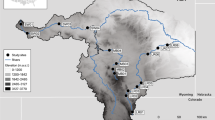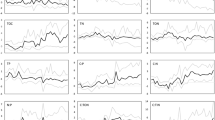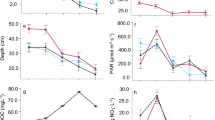Abstract
Hydrological regime alteration in reservoirs is a major anthropogenic disturbance in aquatic ecosystems. We examined winter drawdown effects on macroinvertebrate abundance and community composition in reservoirs while accounting for localized physical variables that might explain additional variability. We hypothesized that drawdown would affect the abundance and the community composition of macroinvertebrates because of the exposure of organisms to freezing and desiccation. However, we expected the detection and magnitude of these responses to be conditional on localized physical habitat variables (i.e., fetch, thermal condition and slope), which also influence abundance and community composition of macroinvertebrates. To test these hypotheses, we applied generalized linear mixed effects models and multivariate analyses to data collected from 118 samples in 15 temperate reservoirs. Sampling stations from reservoirs that experienced high winter drawdown and/or were below the thermocline showed significantly lower macroinvertebrate abundances. Changes in community composition across sites were muted as chironomids, oligochaetes and sphaeriids dominated all assemblages. Decreases in macroinvertebrate abundances with drawdown amplitude and lower temperatures (i.e., hypolimnion) could have implications for food web structure, as they substantially contribute to fish diet, and ecosystem functions (e.g., nutrient cycling).



Similar content being viewed by others
References
Anderson, N. H. & K. W. Cummins, 1979. Influences of diet on the life histories of aquatic insects. Journal of the Fisheries Research Board of Canada 36: 335–342.
Anderson-Nichols and Company, Inc., 1978. Lake Memphremagog, Vermont: A Hydrologic and Hydraulic Analysis. Anderson-Nichols and Company, Inc., Barre.
Aroviita, J. & H. Hämäläinen, 2008. The impact of water-level regulation on littoral macroinvertebrate assemblages in boreal lakes. Hydrobiologia 613: 45–56.
Bailey, R. C., R. H. Norris & T. B. Reynoldson, 2001. Taxonomic resolution of benthic macroinvertebrate communities in bioassessments. Journal of the North American Benthological Society 20: 280–286.
Barko, J. W. & W. F. James, 1998. Effects of submerged aquatic macrophytes on nutrient dynamics, sedimentation, and resuspension. In Jeppesen, E., M. Søndergaard, M. Søndergaard & K. Christoffersen (eds), The Structuring Role of Submerged Macrophytes in Lakes. Springer, Cham: 197–214.
Baumgärtner, D., 2004. Principles of Macroinvertebrate Community Structure in the Littoral Zone of Lake Constance. University of Konstanz.
Baxter, R. M., 1977. Environmental effects of dams and impoundments. Annual Review of Ecology and Systematics 8: 255–283.
Beckett, D. C., T. P. Aartila & A. C. Miller, 1992. Contrasts in density of benthic invertebrates between macrophyte beds and open littoral patches in Eau Galle Lake, Wisconsin. American Midland Naturalist 127: 77–90.
Bolker, B. M., M. E. Brooks, C. J. Clark, S. W. Geange, J. R. Poulsen, M. H. H. Stevens & J.-S. S. White, 2009. Generalized linear mixed models: a practical guide for ecology and evolution. Trends in Ecology and Evolution 24: 127–135.
Bowman, M. F. & R. C. Bailey, 1997. Does taxonomic resolution affect the multivariate description of the structure of freshwater benthic macroinvertebrate communities? Canadian Journal of Fisheries and Aquatic Sciences 54: 1802–1807.
Burnham, K. P. & D. R. Anderson (eds), 2004. Model Selection and Multimodel Inference. Springer, New York.
Caires, A. M. & S. Chandra, 2012. Conversion factors as determined by relative macroinvertebrate sampling efficiencies of four common benthic grab samplers. Journal of Freshwater Ecology 27: 97–109.
Carmignani, J. R. & A. H. Roy, 2017. Ecological impacts of winter water level drawdowns on lake littoral zones: a review. Aquatic Sciences. https://doi.org/10.1007/s00027-017-0549-9.
Carpenter, S. R. & D. M. Lodge, 1986. Effects of submersed macrophytes on ecosystem processes. Aquatic Botany 26: 341–370.
Charest, R., S. Poulin & M. Daoudi, 2008. Synthèse des connaissances – Parc national de Frontenac. Parcs Québec, Parc national de Frontenac.
Diehl, S., 1992. Fish predation and benthic community structure: the role of omnivory and habitat complexity. Ecology 73: 1646–1661.
Elchyshyn, L., J.-O. Goyette, É. Saulnier-Talbot, R. Maranger, C. Nozais, C. T. Solomon & I. Gregory-Eaves, 2018. Quantifying the effects of hydrological changes on long-term water quality trends in temperate reservoirs: insights from a multi-scale, paleolimnological study. Journal of Paleolimnology 60: 361–379.
Furey, P. C., R. N. Nordin & A. Mazumder, 2004. Water level drawdown affects physical and biogeochemical properties of littoral sediments of a reservoir and a natural lake. Lake and Reservoir Management 20: 280–295.
Furey, P. C., R. N. Nordin & A. Mazumder, 2006. Littoral benthic macroinvertebrates under contrasting drawdown in a reservoir and a natural lake. Journal of the North American Benthological Society 25: 19–31.
Hershey, A. E., G. A. Lamberti, D. T. Chaloner & R. M. Northington, 2010. Aquatic insect ecology. In Thorp, J. H. & A. P. Covich (eds), Ecology and Classification of North American Freshwater Invertebrates. Elsevier, Inc., Amsterdam: 659–694.
Jones, F. C., 2008. Taxonomic sufficiency: the influence of taxonomic resolution on freshwater bioassessments using benthic macroinvertebrates. Environmental Reviews 16: 45–69.
Legendre, P. & L. F. J. Legendre, 2012. Numerical Ecology. Elsevier, Amsterdam.
Leira, M. & M. Cantonati, 2008. Effects of water-level fluctuations on lakes: an annotated bibliography. Hydrobiologia 613: 171–184.
Levesque, P., 2003. État de la communauté ichtyologique du lac Aylmer et particulièrement de la population de doré jaune (Stizostedion vitreum) 1998–2001. Société de la Faune et des parcs du Québec, Direction de l’aménagement de la faune de l’Estrie.
Lindström, T., 1973. Life in a lake reservoir: fewer options, decreased production. Ambio 2: 145–153.
McEwen, D. C. & M. G. Butler, 2010. The effects of water-level manipulation on the benthic invertebrates of a managed reservoir. Freshwater Biology 55: 1086–1101.
Merritt, R. W. & K. W. Cummins, 1996. An Introduction to the Aquatic Insects of North America. Kendall Hunt, Dubuque.
Mörtl, M., 2003. Biotic Interactions in the Infralittoral of Lake Constance. University of Konstanz.
Nalepa, T. F., M. A. Quigley & R. W. Ziegler, 1988. Sampling efficiency of the Ponar grab in two different benthic environments. Journal of Great Lakes Research 14: 89–93.
Oksanen, J., F. G. Blanchet, R. Kindt, P. Legendre, P. R. Minchin, R. B. O’Hara, G. L. Simpson, P. Solymos, M. H. H. Stevens & H. Wagner, 2015. Ordination methods, diversity analysis and other functions for community and vegetation ecologists. https://cran.r-project.org/web/packages/vegan/index.html.
Plante, C. & J. A. Downing, 1989. Production of freshwater invertebrate populations in lakes. Canadian Journal of Fisheries and Aquatic Sciences 46: 1489–1498.
Prairie, Y. & A. Soucisse, 1999. Rapport sur le suivi de la qualité des eaux. Département des sciences biologiques, Université du Québec à Montréal.
Quennerstedt, N., 1958. Effect of water level fluctuation on lake vegetation. Verhandlungen der internationalen Vereinigung für theoretische und angewandte Limnologie 13: 901–906.
R Core Team, 2013. R: A Language and Environment for Statistical Computing. R Foundation for Statistical Computing, Vienna. http://www.R-project.org/.
Rabe, F. W. & F. Gibson, 1984. The effect of macrophyte removal on the distribution of selected invertebrates in a littoral environment. Journal of Freshwater Ecology 2: 359–371.
RAPPEL, 2006. Diagnostic environnemental global du bassin versant immédiat du lac Massawippi. Association pour la protection du lac Massawippi, Inc.
Rasmussen, J. B., 1988. Littoral zoobenthic biomass in lakes, and its relationship to physical, chemical, and trophic factors. Canadian Journal of Fisheries and Aquatic Sciences 45: 1436–1447.
Rasmussen, J. B. & D. J. Rowan, 1997. Wave velocity thresholds for fine sediment accumulation in lakes, and their effect on zoobenthic biomass and composition. Journal of the North American Benthological Society 16: 449–465.
Rodhe, W., 1964. Effects of impoundment on water chemistry and plankton in Lake Ransaren (Swedish Lappland). Verhandlungen der internationalen Vereinigung für theoretische und angewandte Limnologie 15: 437–443.
Rosenberg, D. M., P. McCully & C. M. Pringle, 2000. Global-scale environmental effects of hydrological alterations: introduction. BioScience 50: 746–751.
Scheifhacken, N., C. Fiek & K.-O. Rothhaupt, 2007. Complex spatial and temporal patterns of littoral benthic communities interacting with water level fluctuations and wind exposure in the littoral zone of a large lake. Fundamental and Applied Limnology – Archiv für Hydrobiologie 169: 115–129.
Schwarz, G., 1978. Estimating the dimension of a model. The Annals of Statistics 6: 461–464.
Skaug, H., D. Fournier, B. Bolker, A. Magnusson & A. Nielsen, 2015. Generalized linear mixed models using AD Model Builder. http://glmmadmb.r-forge.r-project.org/.
Vadeboncoeur, Y., M. J. V. Zanden & D. M. Lodge, 2002. Putting the lake back together: reintegrating benthic pathways into lake food web models. BioScience 52: 44–54.
Vermaire, J. C., Y. T. Prairie & I. Gregory-Eaves, 2011. The influence of submerged macrophytes on sedimentary diatom assemblages. Journal of Phycology 47: 1230–1240.
Vörösmarty, C. J., P. B. McIntyre, M. O. Gessner, D. Dudgeon, A. Prusevich, P. Green, S. Glidden, S. E. Bunn, C. A. Sullivan, C. R. Liermann & P. M. Davies, 2010. Global threats to human water security and river biodiversity. Nature 467: 555–561.
Wagner, T. & C. M. Falter, 2002. Response of an aquatic macrophyte community to fluctuating water levels in an oligotrophic lake. Lake and Reservoir Management 18: 52–65.
Warwick, R. M., 1988. The level of taxonomic discrimination required to detect pollution effects on marine benthic communities. Marine Pollution Bulletin 19: 259–268.
Weatherhead, M. A. & M. R. James, 2001. Distribution of macroinvertebrates in relation to physical and biological variables in the littoral zone of nine New Zealand lakes. Hydrobiologia 462: 115–129.
Wetzel, R. G., 2001. Limnology: Lake and River Ecosystems. Gulf Professional Publishing, Houston.
White, M. S., M. A. Xenopoulos, K. Hogsden, R. A. Metcalfe & P. J. Dillon, 2008. Natural lake level fluctuation and associated concordance with water quality and aquatic communities within small lakes of the Laurentian Great Lakes region. Hydrobiologia 613: 21–31.
White, M. S., M. A. Xenopoulos, R. A. Metcalfe & K. M. Somers, 2010. On the role of natural water level fluctuation in structuring littoral benthic macroinvertebrate community composition in lakes. Limnology and Oceanography 55: 2275–2284.
White, M. S., M. A. Xenopoulos, R. A. Metcalfe & K. M. Somers, 2011. Water level thresholds of benthic macroinvertebrate richness, structure, and function of boreal lake stony littoral habitats. Canadian Journal of Fisheries and Aquatic Sciences 68: 1695–1704.
Wilcox, D. A. & J. E. Meeker, 1992. Implications for faunal habitat related to altered macrophyte structure in regulated lakes in northern Minnesota. Wetlands 12: 192–203.
Zuur, A., E. N. Ieno, N. Walker, A. A. Saveliev & G. M. Smith, 2009. Mixed Effects Models and Extensions in Ecology with R. Springer, New York.
Acknowledgements
This work was supported by the Conseil Régional de l’Environnement Chaudière-Appalaches (CRECA), Parc National de Frontenac, Regroupement pour la Protection du Grand Lac St-François (RPGLSF), Fondation de la Faune du Québec, Centre de la Science de la Biodiversité du Québec (CSBQ), Mathematics of Information Technology and Complex Systems (MITACS) and WSP Global Group, Inc., as well as McGill University and Université du Québec à Rimouski (UQAR). We thank many assistants for their hard work in the field. We are also very appreciative of Cristian Correa’s assistance both in the field and with the preliminary reservoir selection process. Three anonymous reviewers provided helpful comments on earlier versions of the manuscript.
Author information
Authors and Affiliations
Corresponding author
Additional information
Handling editor: María del Mar Sánchez-Montoya
Publisher's Note
Springer Nature remains neutral with regard to jurisdictional claims in published maps and institutional affiliations.
Electronic supplementary material
Below is the link to the electronic supplementary material.
10750_2019_3922_MOESM1_ESM.xlsx
Supplementary material 1 (XLSX 53 kb) Table A1 Table showing the temperature (°C, degree Celsius) and dissolved oxygen (DO, mg/l) as a function of depth profile at the deepest point of each reservoir. Thermocline is identified by the dashed boxes in the table. In reservoirs labelled with as asterisk, DO was converted from % saturation values to mg/l values with USGS DOTABLES—Single-Value Computation (https://water.usgs.gov/software/DOTABLES/) using local temperature and barometric pressure data. The deepest Ponar grab in each reservoir was collected at 16 m, with the exception of two reservoirs (FLA and UMB) where the deepest site was indeed oxygen-rich (> 6 mg/l oxygen). Cells with “–” mean that this particular depth was not sampled and empty cells mean that the reservoirs did not encompass those depths (i.e., shallower water bodies)
10750_2019_3922_MOESM2_ESM.xlsx
Supplementary material 2 (XLSX 67 kb) Table A2 Raw data tables detailing sample number (SAMPLE_NUM), sample name (SAMPLE_NAME), fetch in kilometers (FETCH_KM), percentage of slope (SLOPE_PERCENT), distance to shore in meters (DIS_TO_SHORE_M), thermal regime (THERMAL_REG), all taxa that were identified in this study are alphabetically sorted and grouped by orders (see Table A3 for metadata on the code names used for each taxa), where taxa column that make up for more than 5% of the total number of organisms identified is bolded, and lastly, the total abundance per grab (TOTAL_AB_PER_GRAB) as well as the total abundance/m2 (TOTAL_AB_PER_M2; n = 118)
10750_2019_3922_MOESM3_ESM.xlsx
Supplementary material 3 (XLSX 46 kb) Table A3 Metadata detailing the taxonomy (phylum, class, order and family) of all taxa as well as their code names. “NA” does not mean that this specific level of taxonomy is not available, it means that taxa were not further identified for this study
Rights and permissions
About this article
Cite this article
Trottier, G., Embke, H., Turgeon, K. et al. Macroinvertebrate abundance is lower in temperate reservoirs with higher winter drawdown. Hydrobiologia 834, 199–211 (2019). https://doi.org/10.1007/s10750-019-3922-y
Received:
Revised:
Accepted:
Published:
Issue Date:
DOI: https://doi.org/10.1007/s10750-019-3922-y




